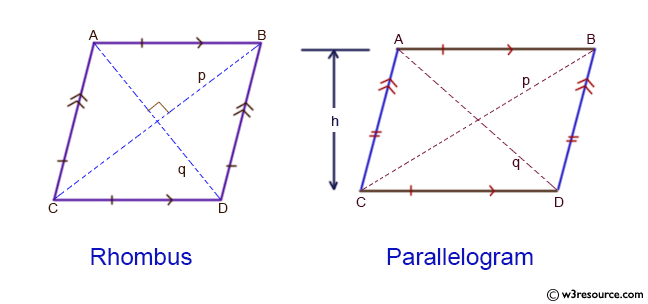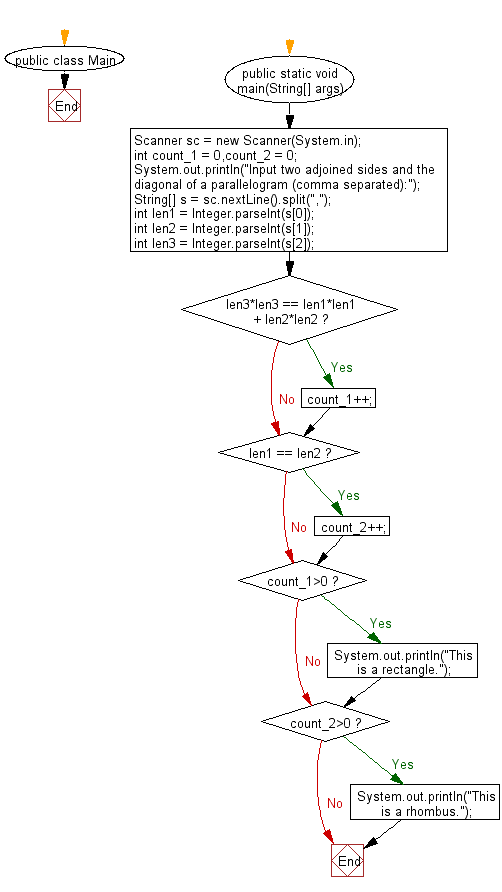Java: Reads the two adjoined sides and the diagonal of a parallelogram and check whether the parallelogram is a rectangle or a rhombus
Check Rectangle or Rhombus from Parallelogram Sides
Write a Java program that reads the two adjoining sides and the diagonal of a parallelogram. It will check whether the parallelogram is a rectangle or a rhombus.
According to Wikipedia-
parallelograms: In Euclidean geometry, a parallelogram is a simple (non-self-intersecting) quadrilateral with two pairs of parallel sides. The opposite or facing sides of a parallelogram are of equal length and the opposite angles of a parallelogram are of equal measure.
rectangles: In Euclidean plane geometry, a rectangle is a quadrilateral with four right angles. It can also be defined as an equiangular quadrilateral, since equiangular means that all of its angles are equal (360°/4 = 90°). It can also be defined as a parallelogram containing a right angle.
rhombus: In plane Euclidean geometry, a rhombus (plural rhombi or rhombuses) is a simple (non-self-intersecting) quadrilateral whose four sides all have the same length. Another name is equilateral quadrilateral, since equilateral means that all of its sides are equal in length. The rhombus is often called a diamond, after the diamonds suit in playing cards which resembles the projection of an octahedral diamond, or a lozenge, though the former sometimes refers specifically to a rhombus with a 60° angle (see Polyiamond), and the latter sometimes refers specifically to a rhombus with a 45° angle.
Input:
Two adjoined sides and the diagonal.
1 ≤ ai, bi, ci ≤ 1000, ai + bi > ci
Visual Presentation:

Sample Solution:
Java Code:
// Importing the Scanner class for user input
import java.util.*;
// Main class named "Main"
public class Main {
// Main method to execute the program
public static void main(String[] args) {
// Creating a Scanner object for user input
Scanner sc = new Scanner(System.in);
// Initializing variables to count occurrences
int count_1 = 0, count_2 = 0;
// Prompting the user to input two adjoined sides and the diagonal of a parallelogram (comma separated)
System.out.println("Input two adjoined sides and the diagonal of a parallelogram (comma separated):");
// Reading the input line and splitting it using commas
String[] s = sc.nextLine().split(",");
// Parsing the string values to integers
int len1 = Integer.parseInt(s[0]);
int len2 = Integer.parseInt(s[1]);
int len3 = Integer.parseInt(s[2]);
// Checking if the parallelogram is a rectangle based on the Pythagorean theorem
if (len3 * len3 == len1 * len1 + len2 * len2)
count_1++;
// Checking if the parallelogram is a rhombus based on equal sides
if (len1 == len2)
count_2++;
// Outputting the result based on the counts
if (count_1 > 0)
System.out.println("This is a rectangle.");
if (count_2 > 0)
System.out.println("This is a rhombus.");
}
}
Sample Output:
Input two adjoined sides and the diagonal of a parallelogram (comma separated): 8,8,8 This is a rhombus.
Flowchart:

For more Practice: Solve these Related Problems:
- Write a Java program to determine if a parallelogram with given sides and one angle is a rectangle.
- Write a Java program to check if a parallelogram is a square based on its side lengths and diagonal.
- Write a Java program to verify if a parallelogram is a rhombus by comparing the lengths of all its sides.
- Write a Java program to decide whether a parallelogram is a rectangle or a rhombus given two adjacent sides and one diagonal.
Go to:
PREV : Count Combinations of Digits with Target Sum.
NEXT : Replace "python" with "java" and Vice Versa.
Java Code Editor:
Contribute your code and comments through Disqus.
What is the difficulty level of this exercise?
Test your Programming skills with w3resource's quiz.
